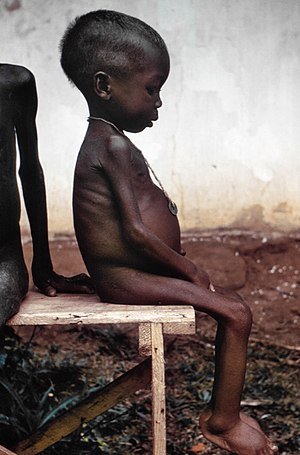Topic Content:
- Nature of Kwashiorkor
- Causes of Kwashiorkor
- Symptoms of Kwashiorkor
- Treatment of Kwashiorkor
- Evaluation Theory Questions & Answers

Nature of Kwashiorkor:
Kwashiorkor is a deficiency disease resulting from a lack of protein in the diet. It is called edematous malnutrition because it is associated with fluid retention.
Kwashiorkor is characterised by an extremely emaciated appearance in all parts of the body with the exception of the ankles, feet and belly which on the contrary swell up with fluid. Kwashiorkor is most common in children.
What Causes Kwashiorkor?
Kwashiorkor is caused by a lack of protein in the diet. Protein is very important for growth during childhood and pregnancy. Growth and normal body functions will begin to shut down when the body lacks protein leading to the development of kwashiorkor.
Symptoms of Kwashiorkor:
- Change in skin and hair colour and texture i.e. having a kind of rust color.
- Loss of muscle mass or emaciationthe state of being abnormally thin or weak. More.
- Swelling of the ankles, feet and belly/oedema.
- Failure to grow or gain weight.
- Damaged immune system, which leads to more frequent and severe infections.
- Fatigue.
- Diarrhoea.
- Irritability.
- Flaky rash.
- Shock.
Prevention:
Kwashiorkor can be prevented by ensuring that enough calories and protein-rich foods are eaten.
Evaluation Questions (Theory):
1. Define non-communicable diseases
2. Outline ten (10) examples of non-communicable diseases
3. Enumerate five (5) causes of non-communicable diseases.



Responses